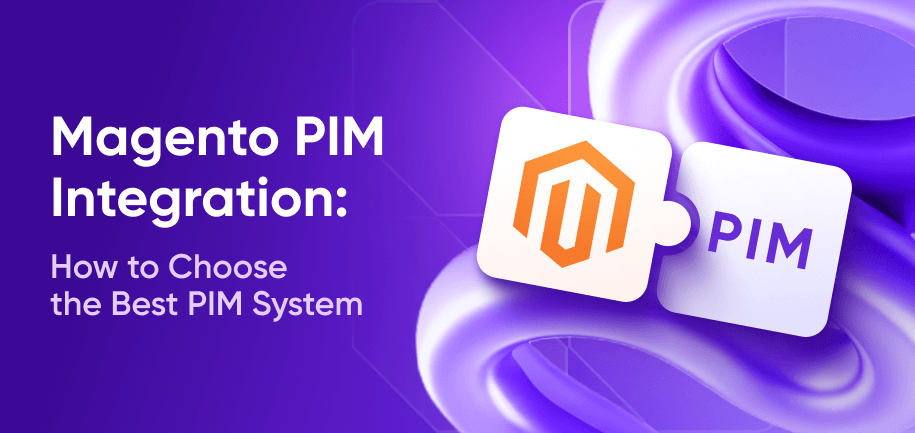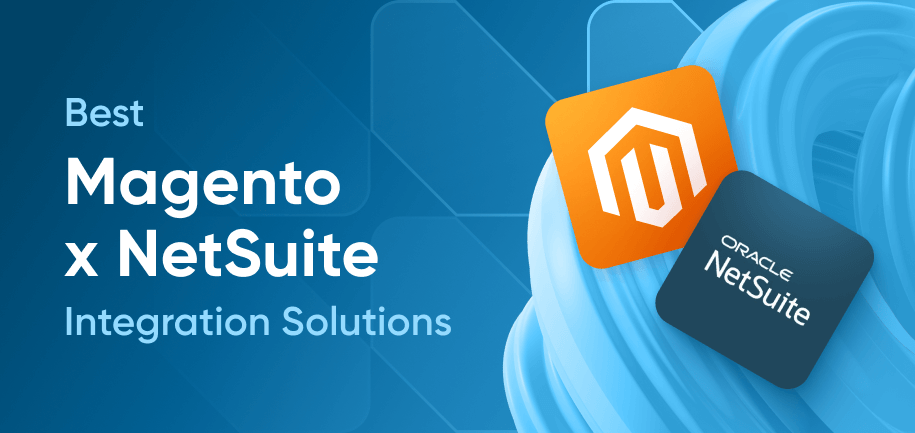Magento Product Information Management is the cornerstone of any Magento-powered e-commerce business. No matter the size of the catalog, PIM software helps merchants to easily organize and disseminate their product data.
In this blog post, we will dive deep into Magento PIM integration and discuss the best PIM systems for Magento. We’ll also provide insights into the Magento 2 PIM integration process, including PIMCore Magento integration and Magento PIM connectors.
But before diving into the integration and best systems, let’s understand what Magento PIMs (Product Information Management Systems) are.
What is Magento PIM?
A Magento PIM platform is a software integrated with the Magento 2 store with the goal of centralizing all existing product data. PIMs help guarantee high product data quality by ensuring the consistency and up-to-date status of all product entities, including:
Product descriptions
Product images
Pricing
Inventory levels
Product specifications
Read More: A Guide to Magento Integrations
Key Benefits of Magento PIM
Integrating PIM with Magento streamlines workflows, improves data accuracy, enhances collaboration among teams, and enables faster time to market. Let's look at these perks in more detail:
Centralized Data Management – Magento PIM integrates all product-related information into one unified system, making it easier to manage and update product data across multiple channels, including e-commerce stores, marketplaces, mobile apps, and in-store displays.
Consistency Across Channels – With a Magento PIM system, businesses can ensure that the same, accurate product information is reflected across all touchpoints. This reduces the chances of errors, inconsistencies, or outdated data that could confuse customers.
Improved Customer Experience – By providing detailed, accurate, and rich product information, Magento PIM helps create a more engaging and informative shopping experience. This leads to higher conversion rates and customer satisfaction.
Efficiency in Workflow – Product data can be managed, updated, and enriched much more efficiently when it is centralized. Teams can quickly add new products, update existing ones, and distribute information across channels without manually updating each one.
Support for Multilingual and Multicurrency Stores – Magento PIM allows businesses to manage product information in multiple languages and currencies, making it easier to operate in international markets.
Best PIM Systems for Magento
When selecting the best PIM system for Magento, you should consider the features offered by the PIM system, ease of integration with Magento, scalability, and support for multi-channel marketing. Below are some of the best PIM systems for Magento:
1. PIMCore Magento Integration
PIMCore is one of the leading open-source PIM solutions that offers seamless integration with Magento. It provides a powerful and flexible platform for managing product data, digital assets, and content across various channels. With PIMCore Magento integration, businesses can take full control over their product data and enrich it with relevant attributes and media, creating a consistent experience across all touchpoints.
Key Features of PIMCore for Magento:
Centralized Data Management: Manage all your product information in one place, from product details to digital assets like images and videos.
Multi-Channel Support: Distribute product data across multiple platforms, including Magento, mobile apps, and marketplaces.
Flexible Data Modeling: Customize data models, so you can store product attributes specific to your business needs.
Content Management: Integrate content management, making it easy to update product descriptions, marketing materials, and other content in real time.
The PIMCore Magento integration ensures that data synchronization between Magento and the PIM system happens automatically, reducing the need for manual updates and enhancing operational efficiency.
2. Akeneo PIM for Magento
Akeneo is another powerful and popular PIM system that integrates well with Magento. It is especially known for its user-friendly interface and robust features for managing product data. Akeneo is a great choice for businesses looking to improve product data management and enhance customer experiences across various sales channels.
Key Features of Akeneo for Magento:
Easy-to-Use Interface: Akeneo's intuitive interface allows users to manage and enrich product data without technical expertise.
Magento 2 Product Information Management: Akeneo offers a Magento 2 PIM integration, allowing you to sync product information seamlessly between Akeneo and your Magento store.
Data Enrichment: Akeneo allows you to enrich product information with additional attributes, images, videos, and content, ensuring that customers have access to comprehensive and up-to-date product details.
Multi-Language and Multi-Currency: Akeneo supports the management of products in multiple languages and currencies, which is beneficial for businesses operating globally.
With Akeneo PIM, Magento users can keep product data consistent across all channels, improve workflows, and provide an enhanced shopping experience to customers.
3. Salsify PIM Integration for Magento
Salsify is a cloud-based PIM system that integrates seamlessly with Magento, enabling businesses to manage their product information across multiple platforms. It offers a comprehensive set of features designed to streamline the product data management process, making it easier for teams to work together and deliver accurate, high-quality content.
Key Features of Salsify for Magento:
Unified Product Data: Salsify consolidates all your product information in one place, making it easier to update and share across your organization.
Omni-Channel Distribution: The tool helps you distribute product content to various channels, including Magento, marketplaces, social media, and retail partners.
Data Analytics: Salsify offers powerful analytics tools that allow you to track how your product data is performing across different channels, helping you make data-driven decisions.
Integration Flexibility: Salsify offers a flexible integration framework, allowing businesses to connect the PIM system to their Magento store and other tools in their e-commerce stack.
Salsify’s PIM solution enables businesses to create rich, consistent product experiences across all customer touchpoints, enhancing brand presence and boosting conversions.
4. InRiver PIM Magento Connector
InRiver is another top-tier PIM solution that can be easily integrated with Magento. It focuses on simplifying the management of product information and content, offering a user-friendly platform that helps e-commerce businesses efficiently organize, enrich, and distribute product data across channels.
Key Features of InRiver PIM for Magento:
Product Data Collaboration: InRiver provides a collaborative platform where teams can work together to enrich product data, ensuring accuracy and completeness.
Magento 2 Integration: The Magento PIM connector for InRiver ensures that product data is synced in real-time between InRiver and your Magento store.
Rich Content Management: InRiver enables businesses to manage rich media assets such as images, videos, and product specifications, providing a more engaging customer experience.
Customization and Flexibility: InRiver offers customizable workflows and data models, making it adaptable to the specific needs of your business.
By using InRiver PIM for Magento, businesses can deliver consistent product experiences and improve their go-to-market time.
Key Steps of Magento 2 PIM Integration
Magento 2 PIM integration allows businesses to streamline product data management across the entire ecosystem of sales channels. Integrating a PIM system with Magento 2 enhances the speed, accuracy, and consistency of product information updates, leading to improved operational efficiency.
1. Select the Right PIM System
First, choose the best PIM system that suits your business needs. Ensure it integrates well with Magento 2 and supports features like multi-channel distribution, data enrichment, and content management.
2. Install and Configure the Magento PIM Connector
Install the appropriate Magento PIM connector for your chosen PIM system. These connectors facilitate seamless data synchronization between Magento and the PIM system, ensuring that product information is updated automatically.
3. Data Migration and Customization
If you are moving from a previous PIM solution or a manual process, you need to migrate product data to the new PIM system. When done, configure data models in the PIM system to reflect your specific product attributes and business requirements. This includes setting up product categories, specifications, pricing models, and more.
4. Testing and Validation
Before going live, thoroughly test the integration to ensure that product data flows correctly between the PIM system and Magento. Validate that all attributes, images, and content are correctly displayed on your online store.
5. Launch and Monitor
Once everything is set up and tested, launch the integration and start managing your product data through the PIM system. Continue to monitor the integration to ensure it remains seamless.
Magento PIM System: Choosing the Right Connector
The key to successful Magento PIM integration is the Magento PIM connector. A good connector will ensure that product data flows smoothly between the PIM system and your Magento store. It’s important to choose a connector that offers the following features:
Real-Time Synchronization: Ensure that product data is synchronized in real time between the PIM system and Magento, reducing errors and outdated information.
Customization: The connector should allow customization to support your unique business needs, including product attributes and data structure.
Scalability: As your product catalog grows, your PIM system and connector should be able to scale to handle larger volumes of data without affecting performance.
Custom Magento Integration Service by Amasty
Looking to connect your Magento or Adobe Commerce store with a Product Information Management (PIM) system? Amasty’s custom Magento Integration Service delivers tailored solutions to seamlessly integrate Magento with any third-party platform, including PIM, ERP, CRM, and more.
What we offer:
Custom Integration Solutions – Whether it’s PIMCore, Akeneo, Salsify, or another platform, we build integration workflows that match your unique business requirements.
Real-Time Data Sync – Keep your Magento product catalog automatically updated with real-time synchronization between Magento and your PIM system.
Expert Support – From setup to ongoing optimization, our team ensures a smooth integration experience with dedicated technical support.
Amasty’s custom Magento PIM integration helps businesses improve efficiency, ensure data accuracy, and scale operations with confidence.
Takeaways
If your Magento-powered business is looking to streamline product data management, enhance customer experiences, and improve operational efficiency, consider opting for a Magento PIM system. With options like PIMCore Magento integration, Akeneo PIM for Magento, and Salsify PIM integration, you can tailor the setup to your unique business needs
Choose a PIM system and connector that work best with Magento 2, and make sure your product data syncs smoothly. This will help you centralize product information, keep it consistent across all channels, and deliver a better experience to your customers.
Frequently asked questions
A Product Information Management (PIM) system is used to centralize and manage product data across various channels and platforms. It helps businesses maintain consistency and accuracy in product information, including descriptions, images, prices, and specifications. A PIM ensures that product data is easily accessible, enriched, and distributed to e-commerce stores, marketplaces, mobile apps, and other sales channels.
Adobe does not offer a dedicated PIM system. However, Adobe Experience Manager (AEM) can be used for content and digital asset management (DAM), which shares some similarities with PIM. Adobe AEM allows businesses to manage and deliver rich product content, but for more extensive product data management, companies may need to integrate AEM with a third-party PIM solution.
Some well-known examples of PIM systems include Akeneo, PIMCore, Salsify, and InRiver. These systems help businesses manage and enrich product information across various sales and marketing channels, providing a unified source of truth for all product data. These systems also offer integration capabilities with e-commerce platforms like Magento, allowing seamless data flow and improved operational efficiency.
















